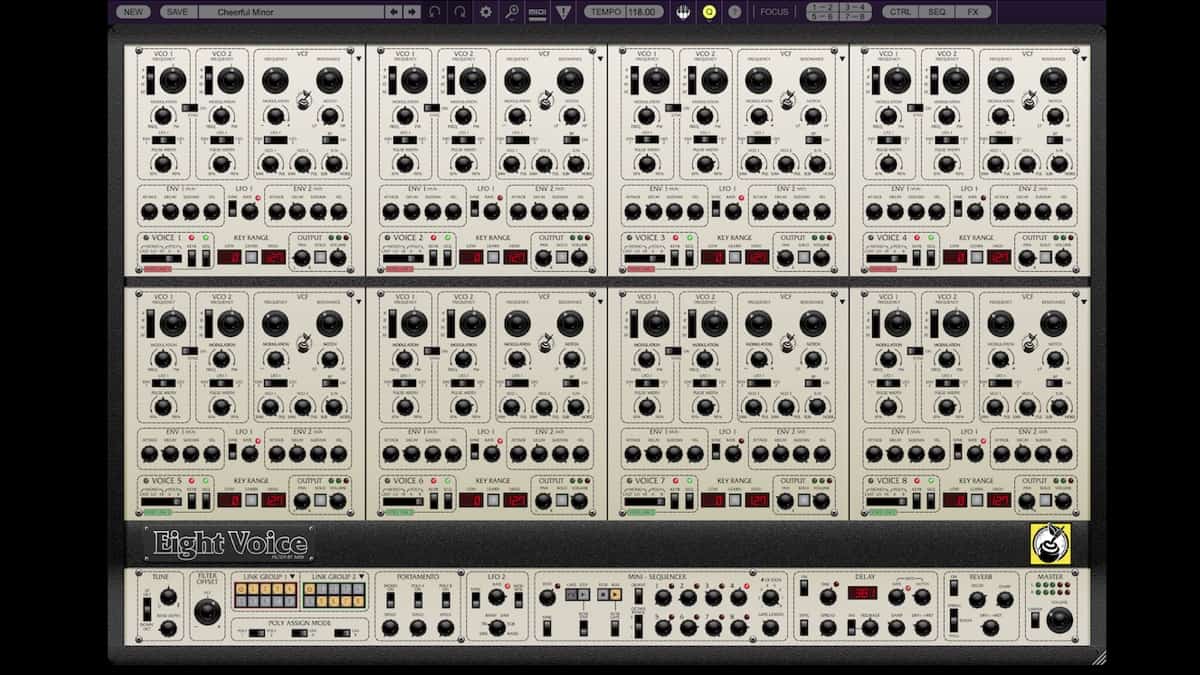Features
Cherry Audio Eight Voice

An Oberheim SEM software recreation comes in at a fraction of the weight with eight times the fat. Marty Cutler lifts it for exercise.
Tom Oberheim was a prime mover in the movement toward polyphony in early synthesizers.
With the development of the Synthesizer Expander Module (SEM), ganging together additional units provided thicker voices as well as expanded polyphony. Better yet, each SEM was capable of independent programming, adding to the richness and complexity of sound.
The SEM was not a complicated instrument – each monophonic module had two oscillators that shared a common 3-stage amp and filter envelope generator. Yet it also marked the beginning of the multimode filter, which was continuously variable between low-and high-pass settings. By itself the synth had no patch memory, but with the Polyphonic Synthesizer Programmer module (PSP-1) it was possible to store 16 patch memories. [So it turns out that we’re only close! Viewer and serious synth enthusiast Doug Slocum of Synthetic Sound Labs called in to point out that the EML Electrocomp 100 and 101 scooped the SEM by a few years. It had variable filters, and also variable waveforms that swept from square to sawtooth to a double-octave sawtooth. – NB]
In general, the SEM was great for fat basses, brassy keys, and pads that provided a relatively consistent background, in contrast to modern-day synthesizer sounds with swirling, looping high harmonics, beating percussive timbres, or tricky timbral motion. As with most synths of the day, it had specific parts to play in music production, and it played them very well without any distracting frills or gimmicks.
Creating more animated sounds required more work and a full complement of modules. As a faithful reproduction of the SEM, Cherry Audio’s Eight Voice softsynth is eminently equal to the task, whether you want simple backdrops, enveloping pads, aggressive polysynths, or fat and punchy basses.
With the eight SEM modules recreated and assembled in Cherry Audio’s Eight-Voice, it’s suitable for creating subtly evolving sounds as well as layers and splits, although, not surprisingly, most of the patches lean toward the more traditional roles, with timbral motion kept to a minimum.
Tales of topological notions: Eight-Voice might appear daunting at first glance, with all eight 2-oscillator modules staring you in the face – until you remember that the user interface for each module is identical; learn one, and you’ve learned them all.
In addition to the SEM’s traditional single LFO per module, Cherry audio graces its version with a second, global LFO, with a choice of sine, triangle, ramp, saw, square, and random-stepped waves.
LFO 1 is sine-wave only, and it runs at a lower frequency-modulation rate than LFO 2. I would have liked an option to toggle a second per-voice LFO, emulation notwithstanding. Still, the software hews closely to its hardware progenitor’s design and sound.
Eight-Voice retains the features that make its hardware forbears unique. For one, the oscillator waveform offers a continuously variable mix between sawtooth and pulse waveforms.
Similarly, each of the eight multimode filters can sweep between low, notch, and high-pass filtering. Naturally, you can vary pulse width to vary timbre between nasal-sounding and hollow.
Overall, Eight-Voice sounds thick and intense. Judicious use of the filter goes a long way toward smoothing the timbre, but an OBX or a Matrix 12 it’s not.
Eight-Voice is a rowdy synth, and that’s as it should be.

UI: Cherry Audio deserves an award for their thoughtful user interface design. A Focus section divides the instrument into four oscillator pairs; clicking on one enlarges the view of that oscillator pair, delivering all controls from astigmatism territory into plain, comfortable view.
An additional panel brings Cherry Audio’s feature set into sharper relief from its ancestor. Along with more conventional global controls, such as tuning, octave, and bend range, options include a Filter Offset to increase or attenuate the filter frequency of all modules.
In the Link Group panel, clicking on a few buttons groups modules so that a parameter changed in one affects all the activated expanders. Better yet, you can set absolute (each unit goes to the same value) or relative (each unit moves incrementally) control of the grouped units. The two available Link Groups are independent, animating changes from subtle to drastic.
Once assigned, the Eight Voice’s MIDI Learn features remain in place for all patches, and are saved and retained the next time you load the instrument. I personally much prefer to treat each patch separately, in which case you have to un- and re-learn MIDI controllers.
There’s plenty more. You can set the range of each module, making keyboard splits a snap. It has a modest but funky 8-step sequencer with control over gate time per step, a syncable delay, and a nice reverb with a choice of spring, room, or hall and a knob for decay and reverb-damping.
It sounds great, it weighs a lot less than an Oberheim Eight-Voice, and sells for $29; how can you possibly go wrong? Download the demo and check it out.
Price: $29



















